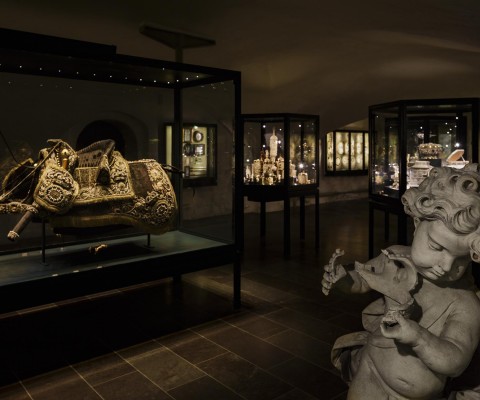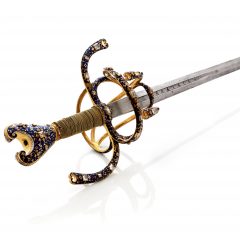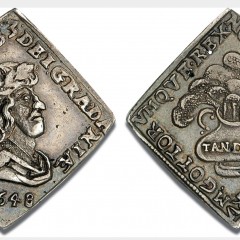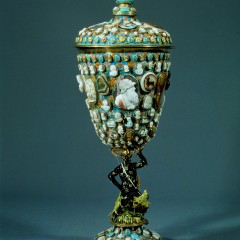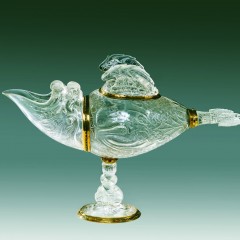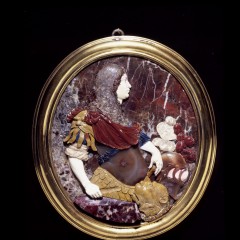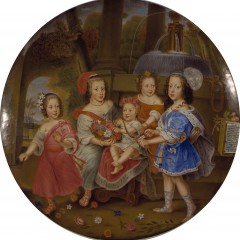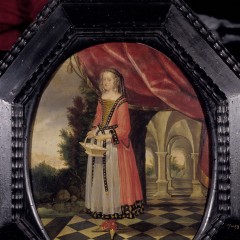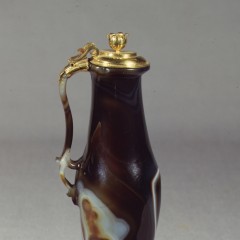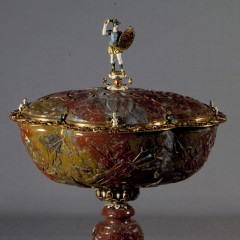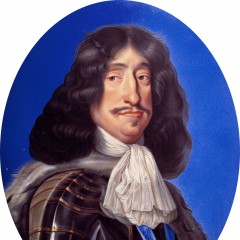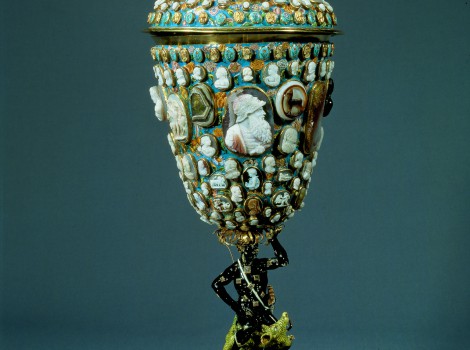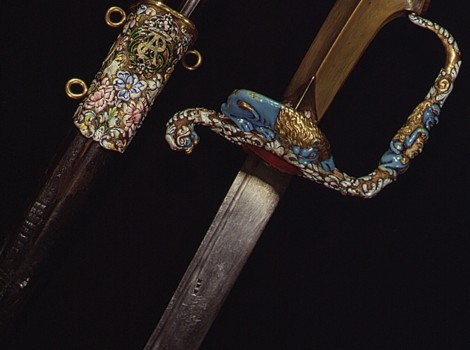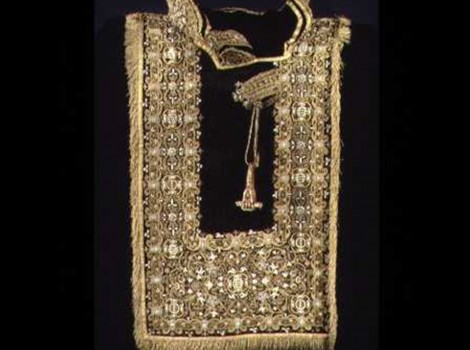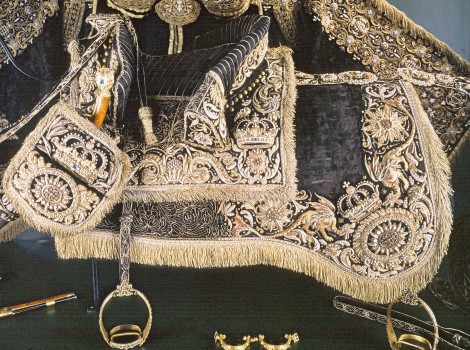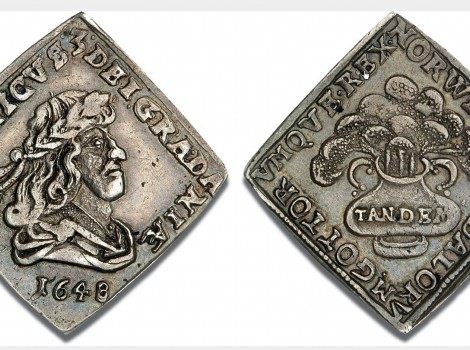E The Green Cabinet
The Green Cabinet, which is today the name of the former Palace kitchen in the basement, was originally the name of a small room next to the Old Regalia Room. In that room, a collection of handicrafts, miniature portraits and parade arms founded by Frederik III was kept.
The collection in the “new” Green Cabinet dates from c. 1200 to 1718 and can be said to represent an important part of what was left of the Royal heritage after the Reformation in 1536 and the defeats of the Thirty Years’ War and the Swedish Wars in the 17th century. Most exhibits are princely presents and come from the personal collections of the Royals.
The items were arranged according to a combination of material and function, and the exhibition was structured to symmetrical principles, which placed the largest and the most noble item at the centre. This principle of exhibition is still used in the way that the exhibits are displayed today.
-
Obejcts in this room
-
3000-3018
3000. Christian IV’s riding trappings, used at his coronation in 1596. Black velvet embroidered with gold and pearls. Made by Peter Paul Perlestikker in Copenhagen. 3002. – 3004. Stirrups and spurs (belonging to no. 3000). Iron and gold with enamel and diamonds. Made by Dirich Fyring, who made Christian IV’s crown? 3006. Sword-hanger. Leather and silk with gold, silver and pearl embroidery of the Pelican in her Piety; the symbol of the Martyrdom of Christ. Used at the coronation in 1596 (no. 5124). 3008. Helmet of velvet with gold embroidery. Worn by Christian IV on his way to Copenhagen Cathedral to be crowned in 1596? 3010. Riding trappings used at the wedding of Christian, the Prince Elect in 1634. Black velvet, embroidered with gold, jewels and pearls. Made by Gert Osserijn in Copenhagen, partly by re-using older pieces of jewellery. 3012. – 3014. Spurs (belonging to no.3010) of gold with diamonds. 3016. – 3018. A pair of pistols. Pommels and mounts of gold with enamel, sapphires and diamonds. Made by Dirich Fyring for Christian IV’s coronation in 1596, but used again in 1634? Pommels and mounts were originally part of ivory pistols. Around 1830 they were transferred to the present pistols from 1690, signed: Heinrich Kappel Kopenhagen. -
3654-3657
3654. Christian IV’s Admiral’s Sword from 1617 with velvet scabbard containing nautical and artillerist measuring instruments. Signed: Christoph Trechsler der Elter Mechanicus Dresden. 3655. Sword with gilt and enamelled hilt, Christian IV’s monogram and the three Danish lions. Worn by the King as a side arm at his coronation in 1596. Made by Mogens Winter in Copenhagen. 3656. Christian IV’s accolade rapier from c. 1617. Hilt with foliage in gold on blue champlevé enamel, set with pointed and table-cut diamonds. The blade is signed: De Tomas / De Aiala. 3657. Rapier worn by the Prince Elect c. 1620. Hilt with blue and white gold enamel richly set with table-cut diamonds. -
3658-3667
3658. – 3660. Rapier, scabbard and spurs. The sword hilt is formed of three snakes, each biting a heart. Gold, enamel and diamonds. Scabbard of brown leather with snake-head motif. Rowel spurs of iron with heavy gold plating and enamelled snakes and hearts. The snakes symbolize wisdom and the hearts courage. Belonged to the Prince Elect. Made for his wedding in 1634? (no. 3010). 3661. – 3662. Rapier with belt. The rapier’s gold enamel hilt has a pommel in the form of an animal’s head, and quillons in the form of a dragon. The blade is signed: Peter Munich. The belt is mounted with snake and mollusc motifs. Belonged to the Prince Elect. Made for his wedding in 1634? (no. 3010). 3663. Traditionally thought to be Frederik III’s “Command Rapier” from the Torstenson War of 1644, with which he severed the arm of a Swede. Blade made by Clemens Dinger, Solingen. 3664. Deer-hunting sword with knife, sheath and belt, decorated with horn, gold and flower enamel. Belonged to Queen Sophie Amalie. 3665. – 3666. A pair of rowel spurs with enamelled lions. 3667. Dress Rapier with hilt of gilded copper, c. 1650. Belonged to Frederik III. -
3668-3677
3668. – 3670. Rapier and spurs mounted with alchemist gold; possibly made by Frederik III’s physician Peter Bülche. 3671. Christian V’s baton with crown set with diamonds. 3672. Dress Rapier with silver hilt, worn by Christian V as Crown Prince. On the blade: De Alonso Perez en Toledo. 3673. Rapier with agate and garnets. Saxony or Denmark, c. 1675? 3674. Hunting set with sword, hunting knife, various smaller knives and belts. Hilts of agate inlaid in silver gilt. France, c. 1680? 3675. Hunting knife with two smaller knives in a sheath. Belonged with the foregoing. 3676. Rapier of steel. Traditionally thought to have been used by Christian V in the Scanian War; the blade is German or Italian. 3677. Christian V’s whip with diamonds. -
3686-3694
3686. Walking stick of ebony and ivory. Bust of Queen Charlotte Amalie carved by Gottfried Wolffram, c. 1690? 3689. Walking stick with sundial and red lacquer. Belonged to Christian V. 3690. Walking stick of cane and silver with artillerist measuring instruments and Dutch measures. Belonged to Christian V as Crown Prince. The Netherlands, the 1660s. 3691. Similar calibre gauge with gold knob and Danish measurements. 3692. Walking stick of bamboo. Knob of enamelled gold with the motto: Chacun a son Tour. Commissioned by Frederik III in commemoration of the Swedish King Carl X Gustav’s sudden death in 1660, the year after his army had stormed Copenhagen. Made by Paul Kurtz? 3693. Calibre gauge with battle hammer of alchemist gold, possibly made by Frederik III’s physician Peter Bülche. 3694. Walking stick of narwhal tusk (unicorn horn). The rubies on the knob conceal holes to a cavity containing aromatic ointment. Enamelling by Paul Kurtz (no. 4023) in 1663. -
4001-4020
Everything of ivory unless otherwise stated: 4001. The Adoration of the Shepherds. Relief after a drawing by Johannes Rottenhammer. Gottfried Wolffram? 4002. Christian V on horseback in front of Copenhagen. Medallion. Gottfried Wolffram, 1693? 4003. The Battle of Køge Bugt 1677. Medallion commemorating the Danish victory over the Swedish navy in the Scanian War. After Christopher Schneider’s gold medal from c. 1685. Gottfried Wolffram? 4004. Apollo flaying Marsyas. The relief depicts the punishment of the gods. After a painting by Jan Liss. Joachim Henne, c. 1680? 4005. Venus with Amor, Ceres and Bacchus. The relief illustrates luxurious living, since there can be no love without bread and wine. After an original by Rubens. 4006. The Golden Age. Relief. Joachim Henne? 4007. Venus and Adonis. The hunt calls, but Venus tries to hold Adonis back. The relief illustrates desire and duty. Joachim Henne? 4009. Christian V and Queen Charlotte Amalie. Double medallion. Wilhelm Heinrich Wessel 1684. 4010. Charlotte Amalie as Ceres. Medallion. Joachim Henne, c. 1670? 4011. Charlotte Amalie. Medallion, signed: GW for Gottfried Wolffram, c. 1690. 4013. – 4014. Powder horns. Northern India (Mughal), 17th cent. 4016. – 4017. Two small recorders of narwhal tusk. One made by a professional instrument-maker, the other by an amateur. From c. 1650? 4018. – 4019. Knife handle and paper folder. 4020. A bobbin mounted in gold with enamelled forget-me-nots. Believed to have been turned by Christian IV as a gift to Queen Anne Cathrine c. 1600? -
4021-4035
4021. Covered goblet of ivory, carved with symbols for good and evil, and for the elements and the senses. Augsburg 1650-60. 4022. Tankard of ivory with carving of the drunken Silenus. Mounting of silver gilt, stamped for Andreas I Wickert, Augsburg 1640-45. 4023. Cup of narwhal tusk, gold and enamel. On the lid a Greenlander symbolizing the Danish king’s mastery of the northern seas. Carved by Jacob Jensen Nordmand 1662; mounting attributed to Paul Kurtz, 1663? 4025. Tankard of pierced ivory with amorous scenes, incl. Susanna bathing, and Lot and his daughters. Mounting of silver gilt, stamped for Heinrich (IV) Hintze, Lübeck c. 1650. 4027. Tankard of ivory with carving of the Rape of the Sabine Women. Mounting of silver gilt; inside the lid Frederik III’s monogram. Carved by Joachim Henne 1667-70. 4029. Tankard of ivory with carving of battle scenes. On the lid a medallion of Christian V on horseback crowned with laurels. Denmark, c. 1680? 4030. Tankard of narwhal tusk, mounted in silver gilt. On the lid a medallion of Hiob and Gunelle, two of the four Greenlanders who came to Denmark in 1654. Carved by Jacob Jensen Nordmand? 4031. Tankard of walrus tusk, mounted in silver. Carved by Jacob Jensen Nordmand? 4032. Covered beaker of ivory and silver gilt. The relief is based on a painting by Jan Liss of soldiers and harlots carousing, symbolizing the vices. Gottfried Wolffram, c. 1690? 4035. Beaker of ivory with carving of the myth of Diana and Actaeon. -
4040-4072
4040. Goblet of ivory with carving of the Judgement of Paris, mounted in silver gilt. Joachim Henne, 1670- 80? 4042. Tankard of narwhal tusk, mother-of-pearl and silver gilt. On the lid engraved Paschal Lamb, inside Christ and the Woman of Samaria. Jacob Jensen Nordmand, 1651. 4044. – 4045. Bagpipe player and spinning woman. Statuettes of ivory and glass. Illustrations of characters the aristocracy might choose for informal fancy dress balls, the so-called “Wirtschaften”. The Netherlands or Dresden, c. 1650? 4048. – 4051. Four putti of ivory symbolizing the four seasons of spring, summer, autumn (winter replaced by air). 4056. – 4058. Three putti of ivory with symbols of fire, water and air. Joachim Henne? 4063. Man answering the call of nature. Snuffbox of ivory with the crown of a hat as screwtop. 4064. Shepherd’s pipe with amorous couple. Ivory. 4065. – 4066. Two boxes of ivory with carved landscapes; on the lids the lacquered monograms of Christian V and Queen Charlotte Amalie. Gottfried Wolffram, 1699. 4068. Pen case of ivory. Andoin Schæff, 1680s? 4072. Hercules struggling with the vices. Statuette of box-wood. Joachim Henne, 1670. -
4073-4089
4073. – 4074. Two spoons with mother-of-pearl bowls and stems of jet, c. 1600. 4077. – 4080. Four spoons of rock crystal with serpentine silver gilt stems. Made for the Prince Elect, whose favourite motif was the serpent. (nos. 3658-3660). 4081. Amulet of rock crystal and silver for jequirity, limestone from the stomach of the crayfish, which was a treasured antidote for eye disorders, heartburn, bladder stones, headaches, flatulence and syphilis. Rock crystal was also effective i.a. against thirst and toothache. 4082. The Tuscany Brilliant; a copy of a large brilliant, part of the Florentine crown jewels. Made of rock crystal with silver gilt mounting; brought back from Italy by Frederik IV in 1709? 4084. Dish of rock crystal mounted in gold with flower enamel. South Germany, c. 1640. 4086. Globe-shaped covered cup of rock crystal. Presumably 12th-13th century Romanesque work from the Rhine-Mosel district, mounted in silver gilt c. 1650. 4087. Goblet of rock crystal mounted in gold with enamel and diamonds. The goblet was originally covered, and was carved Freiburg im Breisgau 1550-1600. The mounting was added in stages between 1650 and 1718. 4089. Standing cup of rock crystal in the shape of a flying fish, presented to Christian V by Queen Sophie Amalie after the fall of Wismar in 1675. Made at the Saracchi studio in Milan c. 1580. -
4090-4109
4091. Covered cup of rock crystal showing Hercules’ fight with the Nemean Lion and the Hydra. The cup consists of separate pieces, assembled and mounted in the 17th century. The high-domed cover, the cylinder and foot were made at the Saracchi studio in Milan at the end of the 16th century. 4092. Goblet of rock crystal supported by a winged genius. On the foot the arms and motto of the Landgrave Carl of Hesse. Signed C.Labert fecit Cassel 1689. Presented to Christian V, brother-in-law of the Landgrave. 4096. Jewel box of cut-glass panes with silver gilt mounting and flower enamel feet. Cutting by Paul Schindler c. 1650-60. 4097. – 4098. A pair of covered jars, engraved with figures and the months of the year. Nuremberg, 1640s? 4102. Bowl of smoky topaz in the form of a mussel with a lion’s mask. The Miseroni studio in Milan 1600-1610. 4103. Vase of smoky topaz with diamond cutting. Carved by Ottavio Miseroni in Prague c. 1620. 4105. Monstrance clock of brass gilt and rock crystal. Minute and hour hands, date and phases of the moon, striking on the hour and each quarter. Signed: ZLA. South Germany, c. 1610. 4106. – 4107. Christian V on horseback; miniature statuettes on marbled columns, made by Johan or Carl Christian van Bracht, c. 1690. 4108. Bowl of Islandic rock crystal, carved by Denis Piengart 1696? -
4110-4129
4111. Dressing case of rock crystal, gold and enamel with toilet requisites, c. 1620? 4112. Neck watch. Dial of gold with diamonds and enamel (en resille sur verre). Octagonal case of facetted rock crystal. Clockwork signed by Caspar Cameel, Strasbourg c. 1620; case made in Freiburg im Breisgau. 4113. Table bell of rock crystal, wound with gold thread. South Germany, c. 1600. Belonged to Leonora Christina. 4114. – 4115. Two glass flagons, engraved with Queen Sophie Amalie’s monogram and arms. Nuremberg, c. 1660? 4118. – 4119. Two signets of rock crystal with lions. China, 17th cent. 4122. – 4123. Two pediments of calcite with double refraction, which is only found at Helgustadir in Island. Presumably made in connection with Erasmus Bartholin’s investigations into the physics of light, which were published in 1669. On the top two amethysts, said to be Norwegian or Islandic. They were possibly polished by Denis Piengart around 1690 to exemplify the occurence of minerals in the king’s northern realms and provinces. 4124. Standing cup of coconut mounted in silver gilt. Carving shows the creation of Eve, the Fall and the Expulsion from the Garden of Eden. Nuremberg, c. 1550. 4125. – 4126. Two covered beakers of gold ruby glass, blown in Schlackenwerth or Reichstadt in Bohemia, and polished by Duke Julius Franz of Saxony-Lauenburg before 1689; the earliest dated examples of the gold ruby glass to which alchemists of the Baroque attributed magical and healing powers. -
4130-4139
4133. Covered goblet of rock crystal, engraved with dallying hens and chickens, illustrating the proverb: Aus diesem Spiel, sind worden viel. 4134. Knife. In silver on the stem FS, Frederik II’s monogram, the year 1570 and MHZGA, the royal motto: Mein Hoffnung Zu Gott Allein. 4135. Beaker engraved with scenes from the Swedish Wars 1658-60: Frederik III on horseback in front of Copenhagen, the sortie on Amager, the battle of Nyborg and the sea battle of The Sound. Signed: JVS? Nuremberg or Saxony, 1660s? -
4140-4149
4140. Pendant in the form of a dolphin with toothpick and earpick. Pearl mounted in enamelled gold with diamonds and rubies. Germany, 1570-90. Large natural pearls were in fashion and hygiene was a sign of rank. 4141. Carrousel riding prize with portrait of Princess Ulrika Eleonora, contest scene and inscription: To the most agile, won by Christian V 1678. Gold with enamel and diamonds; enamel ascribed to Paul Prieur. 4142. Relief medallion of Diana, composed of semi-precious stones of different colours. Ottavio Miseroni in Prague, c. 1605. 4143. Emperor Rudolf II, cameo of shell, mounted in a frame of 24 rubies and crown of gold enamel. Cameo South Germany, c. 1600; mounting c. 1650. 4146. Ring of enamelled gold with 22 diamonds, upon which a woman’s hand grasping a phallos; inside inscription: TAMQVAM NON HABENS. Possibly Frederik III’s comment on Queen Sophie Amalie’s affair with the valet Jacob Petersen which was discovered in 1664, when the King and Queen had been married for 22 years. 4147. Cupid. Pendant of enamelled gold with rubies and diamonds. The Nederlands, c. 1600. A similar item of jewellery was part of Queen Anne Cathrine’s dowry in 1597. -
4150-4199
4150. Carrousel riding prize, donated by Queen Charlotte Amalie. Belongs together with no. 4141. 4151. Bust of an emperor. Chalcedony cameo in gold mount. Italy, 1550-1600? 4154. Crane. Pendant of pearls and enamelled gold with diamonds, rubies and emeralds. The crane is holding a stone in each claw, symbolizing vigilance, since if it fell asleep it would drop the stones and wake up. Northern Europe, c. 1610. 4155. Monkey’s head. Pomander of girasol in enamelled gold. Inside an aromatic sponge and enamelled motifs with French inscriptions satirizing human frailty. On the back a mirror. Belonged to Leonora Christina; purchased at Corfitz Ulfeldt’s embassy in Paris 1647? 4157. Carrousel riding prize donated by the Dowager Queen Sophie Amalie. Belongs with nos. 4141 and 4150. 4158. Omphale. Cameo of onyx mounted in silver gilt. A favourite motif in Greek legend was Hercules’ sojourn with Omphale, Queen of Lydia, where he dressed as a woman and spun wool with her terns while Omphale wore his lionskin. Italy, 1550-1600. 4161. Lucretia. Pendant of chalcedony, mounted in gold with rubies and emeralds. France, c. 1550. 4179. Hercules. Onyx cameo mounted in gold. Italy 1550-1600? 4188. The Virgin Mary? Medallion of so-called aventurine glass with “grains of gold” of crystallized copper oxide. Made in Venice by Vicenzo Miotti? Brought back by Frederik IV from Italy in 1709? 4196. The Adoration of the Magi. Cameo of onyx mounted in gold with enamel. Alessandro Masnago or studio in Milan 1575-1600? -
4200-4249
4204. Locket with cameo of Hercules and the Nemian Lion, surrounded by the heads of 13 emperors. Hercules carved after a drawing by Albrecht Dürer from 1511 and belonging to a group of shell cameos from c. 1520, made in Nuremberg or France. The emperor series, of onyx, is later. The enamelled mounting with green stones can be dated to c. 1630. 4213. Female figure in enamel. Burgundian work from c. 1500? 4219. Emperor Ferdinand I. Shell cameo mounted in silver. Part of an emperor series. 4223. Horse and man. Sardonyx cameo in silver gilt mounting. Alessandro Masnago or studio, Milan 1575-1600? 4229. Young Roman. Sardonyx cameo. 4233. Hat medallion showing Mars. Onyx, ivory, lapis lazuli and enamelled gold. France, c. 1550. 4242. Christian, the Prince Elect. Cameo of bloodstone mounted in gold enamel. Below the shoulder PEC: Pietas Et Constantia, the Prince’s motto. Denmark, 1620-30. 4246. Julius Caesar. Cameo of onyx in gold mounting. 17th cent. -
4250-4299
4250. The Landing of Noah’s Ark. Onyx cameo after an engraving by Bernhard Salomon 1554. Ascribed to Alessandro Masnago or studio in Milan 1575-1600. Mounted as a pendant in enamelled gold. On the back a crowned K for Kirsten Munk, Christian IV’s morganatic wife. Confiscated from her daughter, Leonora Christina, by Frederik III. 4258. St Paul. Cameo of zircon, mounted in a pomander of gold enamel with rubies and pendant pearls. On the back, lid of a capsule to contain spices. On the cameo the name of the Apostle and the year 41. Northern Europe, 1641? 4278. – 4280. Knife, fork and spoon with handles of agate in enamelled gold. Johann Kobenhaupt or studio, Stuttgart, 1609-1623. 4284. – 4285. Knife and fork with handles of agate mounted in silver; the blade with stamped mark for William Balls, London Cutlers’ Company, 1630-50. 4291. Knive with hilt of agate mounted in silver; the blade stamped with mark for the London Cutlers’ Company, 1606-25. 4297. – 4298. Knife and fork mounted in gold enamel with garnets; blade with stamped harpoon. 1575-1600? -
4300-4349
4310. Standing cup and cover of heliotrope, mounted in enamelled gold and set with cameos. France, c. 1650? 4313. Standing cup of agate, mounted in enamelled gold. As cover finial Venus with a dolphin. Johann Kobenhaupt or studio, Stuttgart, 1609-23. 4316. Standing cup and cover of agate, mounted in gold enamel with rubies. Paris, 1620-50. 4317. Goblet of garnet, mounted in gold with flower enamel and pearls. The body dates possibly from antiquity and was presumably a separate bowl. Carved by Dionysio Miseroni and mounted by Hanns Reinhardt Taravell in Prague in 1655. 4318. Salt of agate, mounted in enamelled and gilt silver. Possibly turned in Venice in the 15th cent. or as “New Gothic” in the early 17th cent.; mounted in Germany, 1600-1630. 4319. – 4320. Two standing cups of agate, mounted in gold enamel. Paris 1630-50? 4333. Mussel-shaped standing cup and cover of bloodstone, carved at the Miseroni studio in Milan or Prague. Gold enamel mounting by Jan Vermeyen, maker of Emperor Rudolph II’s cown, in Prague c. 1600. 4335. Octofoil bowl of honey-coloured agate, the wall carved with arching separated by fluting. The shape is reminiscent of Mughal hardstone carving; the gravity suggests Europe, 17th century. 4336. Bowl of chalcedony onyx. The tapering oval shape and parrot handles are known both in Ottoman and Mughal metalwork. Turkey or India, 17th century. 4337. – 4338. Presentation tray and covered cup of agate, mounted in enamelled gold. Augsburg, 1650? -
4350-4374
4353. – 4354. Two salts of agate; mounted by Jan Vermeyen or studio, Prague 1602-06? 4355. Bowl of porcelain jasper from Grossalmerode in Hesse, mounted in filigree silver, c. 1675? The bowl belonged to Queen Charlotte Amalie, sister of the Landgrave Carl of Hesse. 4361. One of originally 6 cups and saucers of jasper. Italy or Løhlbach in Hesse. 4373. Bowl on foot of heliotrope, mounted in gold enamel. Johann Kobenhaupt, Stuttgart, 1609-23. 4374. Standing cup and cover with stem in the shape of a Moor riding on a dragon. Gold enamel, set with cameos and intaglios of ancient gods, emperors and of European rulers. The individual cameo or intaglio was much prized as an art form during the Renaissance, when the ancient art of stone-cutting was revived. After 1600 the use of carved stones as decorations on objects became the fashion, leading to a serial production of the craft. The colours, flowers and exotic fruits of the enamel date the goblet to 1635-50. (The figure of the Moor from c. 1610). The enamelling possibly done in The Netherlands, the stone-cutting in Prague, although the place of origin is unknown. The goblet, which belonged to the Duchess Frederikke Amalie of Holstein-Gottorp, was found at Gottorp Palace in 1734 and restored by the court Jeweller Frederik (I) Fabritius. Entered the Green Cabinet in 1736. Associated with no. 4654. -
4375-4389
4377. The Landgrave Carl of Hesse (1654-1730). Relief of semi-precious stone in brass frame with his monogram and motto on the back. The relief ascribed to Francesco Mugniai, Cassel 1701-10. 4378. – 4379. William III of England (1650-1702) and Mary (1662-1695). Miniatures. 4380. – 4381. Prince George (1653-1708) and Queen Anne (1665-1714) of Great Britain. Enamel signed by Charles Boit, 1705 and 1705. 4382. Frederik III and Sophie Amalie; engraved mother-of-pearl inlaid in slate, made by Jeremias Hercules? The Queen’s portrait was not included in the Green Cabinet, and is not a pendant to the King’s since she is reproduced in a larger format. 4383. – 4384. Christian IV and Kirsten Munk. Gouaches signed by Jacob van Doordt 1623. Sketches for now lost parade portraits; the King is wearing his coronation side-rapier (no.3655). 4385. Queen Charlotte Amalie in triumphal chariot. Engraved mother-of-pearl, inlaid in slate. Made by Jeremias Hercules? 4386. The royal coat-of-arms. Enamel, signed by Josias Barbette, 1694. 4387. Louis the Pious of France (1215-70). Enamel by Paul Prieur? In 1718 believed to depict Christian I, the first of the Oldenborg kings. 4388. Christian IV 1611. Miniature ascribed to Jacob van Doordt; locket made by Paul Kurtz 1656? 4389. Christian IV 1616. Miniature ascribed to Jacob van Doordt. -
4390-4399
4390. Queen Anne Cathrine 1612. Miniature ascribed to Jacob van Doordt; contemporary locket of gold enamel. 4391. Christian IV 1638-40. Miniature. Locket Danish? 4392. The Electress Anna of Brandenburg (1576-1625). On the back her husband Johan Siegmund (1572-1619), brother of Queen Anne Cathrine. Miniature in oil from 1612. Believed in 1718 to depict the Duchess Elisabeth of Brunswick, sister of Christian IV. 4393. Christian IV 1645. Miniature in oil, by Karel van Mander? After losing an eye at the Battle of Kolberger Heide in 1644 (no. 345), the King only allowed himself to be shown in profile. 4394. Christian, the Prince Elect 1642-43. Miniature in oil, by Karel van Mander. 4395. Christian IV 1640. Miniature in oil, by Karel van Mander? 4396. Christian IV 1645. Miniature in oil, by Karel van Mander? 4397. Frederik III, c. 1645. Miniature in oil, by Karel van Mander? Frederik III became heir to the throne only after the death of his brother, the Prince Elect, in 1647, but he had himself painted with a hair plait, characteristic of Christian IV. 4398. – 4399. Christian V and Queen Charlotte Amalie 1672. Miniatures signed by Louis Goullon; lockets by Paul Kurtz? -
4400-4429
4400. – 4402. The Electress Anna Sophie of Saxony (1647-1717), Queen Ulrika Eleonora of Sweden (1656- 93) and the Electress Wilhelmine Ernestine of Pfalz (1650-1706), Christian V’s sisters, 1680. Miniatures by Louis Goullon. 4403. Prince George, Christian V’s brother, 1674. Miniature by Louis Goullon. 4404. Queen Anne of Great Britain, Wife of Prince George, 1680s. Miniature. 4405. – 4406. Christian V and Queen Charlotte Amalie 1670. Miniatures signed by Maria Augustine Duchastel. 4407. Duchess Frederikke Amalie of Holstein-Gottorp (1649-1704), Christian V’s sister, 1680. Miniature by Louis Goullon. 4408. The royal coat-of-arms; on the back Christian V’s monogram. Enamel medallion by Josias Barbette, 1696-97. 4409. Princesse Sophie Hedvig (1677-1735), Christian V’s daughter, c. 1695. Enamel by Josias Barbette. 4410. The Adoration of the Shepherds. Relief of oak, dated 1633, in later medallion of tortoiseshell and brass. 4411. Princess Sophie Hedvig. Miniature, variant of 4409. 4423. – 4424. Two knife handles of blue glass, mounted in silver gilt. Made by Christian Albrecht Kunckel at Christianhavn’s Glassworks or by Francois Augier at the glassworks behind the Stock Exchange, 1690-92. 4427. Knife handle of girasole, mounted in silver gilt. Belonged to Leonora Christina; confiscated by Frederik III 1661 (nr. 4155). -
4430-4449
4435. Cup of black jade with dragon handle, mounted in filigree gold with turquoises, rubies, emeralds and rock crystal. The cup was carved in Samarkand c. 1425-50, or in Turkey c. 1600; the mounting is Ottoman. Belonged to Christian, the Prince Elect. 4440. Lekytos of onyx. The pitcher presumably dates from antiquity; the gold mounting from 17th cent. Belonged to Leonora Christina. 4441. Jewel box with Biblical figures. Agate inlaid in enamelled gold with rubies. South Germany, c. 1600. 4442. Standing cup of lapis lazuli; on the cover a gold figure of Pallas Athene. Cover and foot carved by Francesco Tortorino, Milan 1550-1600; body turned in South Germany? 4443. Mussel-shaped standing cup of jade, mounted in enamelled gold. The Miseroni studio in Milan c. 1580. 4444. Standing cup and cover of agate jasper mounted in silver gilt enamel. Hans Jakob Mair or Heinrich Mannlich, Augsburg, c. 1680 (no. 5180). 4446. Jade bowl with snake handle and tortoise foot of enamelled gold. From c. 1640. 4448. Pot of white jade with cover of filigree gold enamel with pearls and emeralds. Pot from Samarkand, 1425-50? Mounting Danish, c. 1600. Belonged to Kirsten Munk. Confiscated from her daughter, Leonora Christina, by Frederik III 1661 and given to Queen Sophie Amalie. -
4450-4472
4450. Standing cup and cover of agate, mounted in gold enamel with rubies and a diamond. Cover carved with the four fields of the Württemberg arms. As cover finial a warrior with Duke Johann Friederich’s arms and title. On the stem signature HK 1620 for Hans (Johann) Kobenhaupt, Stuttgart. Presumably a gift from the Duke, Christian IV’s brother-in-law. Donated as a carrousel riding prize by Queen Sophie Amalie in 1680 and won by Christian V. 4451. Bowl of porphyry from Helgeland, south of Trondheim, which Christian V passed through on his 4,500 km royal progress through Norway in 1685. Carved by Denis Piengart, who was sent to Norway to search for minerals in 1688. 4452. Bowl of stone from a river in the Pyrenees with inlaid ornamentation and angel mask in gold. Carved by Master Benedict in Navarre before 1555; presumably presented to Frederik II together with the Order of St Michael in 1559. 4456. Nautilus cup with carved reliefs of Frederik III and Sophie Amalie and their arms, 1666-1670. 4458. Tazza of agate jasper in silver gilt with garnets. The dragons of the handles and the auricular ornamentation of the foot date the cup to 1640-50. 4463. Standing cup and cover of Bohemian agate from Turnov (Kozákov). The gold enamel mounting on the cover made in Prague,c. 1580? The rings on the foot and stem, set with garnets, are repairs from before 1718. 4465. Tureen of gold enamel, set with cameos and intaglios; on the handles Moors’ heads with pearl wreaths. Prague or The Nederlands, c. 1650? Presumably belonged to Queen Charlotte Amalie. 4466. Octagonal casket of partly enamelled gold, set with cameos, intaglios and semi-precious stones. In the lid rock crystal with engraved winter landscape. Northern Europe, c. 1650? 4467. Salt of jaspis, mounted in silver gilt with head of a Turk, a female and a bacchus figure with mother-of-pearl and pearls. Central Europe, 1630-50? 4472. Woman’s head. Back of the head of Saxon serpentine, face partly of silver and enamel gilt. Saxony 1635-50? Drinking bowl, possibly reliquary holder with a new cover? -
4473-4489
4473. Frederik III. Enamel, signed Paul Prieur 1663. The portrait is a masterpiece, since the enamel’s melting point limits both the number of colours and the size of the miniature. 4474. – 4475. Frederik III and Queen Sophie Amalie. Miniatures by Alexander Cooper 1655; the gold enamel lockets from 1656 by Paul Kurtz? 4476. Frederik III. Enamel by Paul Prieur, c. 1660. 4477. Queen Sophie Amalie 1680. Miniature by Louis Goullon. 4478. – 4481. Christian V as Crown Prince and Princesses Anna Sophie, Frederikke Amalie and Wilhelmine Ernestine, 1655. Belong with nos. 4474-4475. 4482. Queen Ulrike Eleonora of Sweden, 1680. Miniature by Pierre Signac. 4483. Frederik III’s five eldest children, including Crown Prince Christian (V), 1652. Enamel after an extinct painting, signed by Paul Prieur 1671. 4484. Queen Sophie Amalie. Enamel by Paul Prieur, c. 1660. 4485. Unknown woman. Miniature, c. 1680. 4486. Frederik III. Miniature, 1650s. 4487. Frederik III. Enamel by Paul Prieur, 1660s. 4488. – 4489. Sophie Amalie as Dowager Queen and Queen Ulrika Eleonora of Sweden, 1680. Miniatures by Louis Goullon. Mounted in lockets set with diamonds to attach on bracelets. -
4490-4500
4490. – 4491. Christian V and Queen Charlotte Amalie. Enamels by Josias Barbette, c. 1690? 4492. Princess Sophie Hedevig, Christian V’s daughter. Enamel, signed by Josias Barbette 1693. 4493. Charles I of Great Britain (1600-49). Miniature in locket of gold enamel; on the back a skull and crossbones. Charles was beheaded in 1649 and was soon considered a martyr, especially after the restoration of the monarchy in 1660. He was the nephew of Christian IV. 4494. Charles II of Great Britain (1630-85). Miniature in gold enamel locket, dated 1660. 4495. James II of Great Britain (1633-1701). Miniature, signed by Susan Rosse, c. 1685. 4496. – 4497. Louis XIV of France (1638-1715. Two enamels by Jean Petitot. 4498. Charles II of Great Britain (1630-85). Enamel, signed by Paul Prieur 1669. 4499. – 4500. Christian V. Enamels, signed by Paul Prieur 1674 and Josias Barbette 1693. -
4501-4519
4501. Michael Korybut Wisniowiecki (1638-73), King of Poland. Enamel, signed by Paul Prieur, 1670. 4502. Queen Christina of Sweden (1626-89) in Rome. Miniature by Pierre Signac. 4503. Lady Castlemaine (1641-1709), Charles II’s mistress. Enamel, signed by Paul Prieur 1669. Pendant to no. 4498. 4504. – 4505. The Landgrave Wilhelm VI of Hesse (1629-63) and the Landgravine Hedvig Sophie (1623-83), Queen Charlotte Amalie’s parents. Miniatures. By Karel van Mander? 4506. The Elector Friedrich Wilhelm of Brandenburg (1620-88), Queen Charlotte Amalie’s uncle. Enamel. 4507. Gustavus II Adolphus of Sweden (1594-1632) on horseback. Cameo. On the back a lion and the motto: Cum deo et victribus armis; with God and the victorious arms. Nuremberg, 1632? 4508. Christoph Berent van Galen, Prince-bishop of Münster (1606-78). Miniature in oil. By Karel van Mander? Van Galen was Denmark’s ally during the Scanian War. 4509. – 4510. Carl X Gustav of Sweden (1622-1660) and Queen Hedvig Eleonora (1636-1715). Miniatures in oil. By Karel van Mander? 4511. Carl XI of Sweden (1655-1697). Miniature by Elias Brenner, presumably a gift at the king’s wedding to Princess Ulrika Eleonora in 1680. -
4520-4599
4526. Intaglio of cornelian. Woman’s head, flanked by two double profiles with another head between the noses; in the hair 5 bearded male heads. 4536. Cameo of onyx with 3 faces, mounted in gold ring with enamel and diamonds; inside: Bollamin Killigrew. Possibly a gift from Captain Killigrew, whose father ran a theatre in London which Crown Prince Christian (V) attended during his travels abroad in 1662? Killigrew made pitchers of stoneware called “bellarmines”, hence his nickname Bollamin. 4545. “Justice on a Monument”. Intaglio of sardonyx mounted in gold. 4558. Cross of the Order of the Dannebrog, sceptre, apple and sword and the three crowns of the Kalmar Union. Intaglio of topaz, mounted in a gold signet ring by Paul Kurtz. Used by Christian V at his anointment in 1671. 4563. Pallas Athene. Intaglio of sardonyx, mounted in portrait locket of silver gilt. 4571. Mars? Intaglio of sardonyx mounted in gold. 4589. Christian V. Intaglio of chalcedony. Denmark, 1670s. 4596. Signet ring of cornelian mounted in silver. Turkey. -
4600-4609
4600. Ring of agate with Cupid blowing soap bubbles, and the inscription: Comme les amis du temps. The ring belonged to Duke Christian Albrecht of Holstein-Gottorp and symbolizes the betrayal of friendship. Although married to Christian V’s sister, Frederikke Amalie, Christian V banished him twice. His marriage was also unhappy. 4601. Ring of jade with crown of thorns and the motto: ad illam per hanc. For its owner, Duke Christian Albrecht of Holstein-Gottorp, a symbol of survival both religious – through suffering to salvation – and political – from banishment to restitution. 4606. Christian IV. Miniature in oil. Jacob van Doordt, c. 1610. 4607. Christian IV. Relief in wax, signed: DVHB 1648. Presumably posthumously, since the King is depicted en face. (cf no. 4393). 4608. Christian V crowned with laurels. Miniature in oil. Jacob d’Agar? 4609. Queen Sophie Amalie in peasant costume. Painted by Wolfgang Heimbach. The Queen was fond of court ballets. In one performance in 1655 she danced no fewer than 5 roles, including one in peasant costume, complete with egg basket, from Vierland, between Altona and Glückstad. -
4611-4624
4611. Wine cup of enamelled copper with drinking scene symbolising the wine harvest, signed P(ierre) R(eymond), Limoges 1552. 4614. Cabinet of ivory, Florentine mosaics and pillars of jasper. Augsburg, 1650-60. The cabinet contained portrait medallions and knick-knacks (including nos. 4615-4645). Ten portrait medallions of ivory, all carved by Johann Heinrich Wessel in the 1680s: 4615. – 4616. Iacob Massau, treasurer in Gottorp, and his wife, Anna Cathrine. 4617. Duke Christian Albrecht of Holstein-Gottorp (1641-94). 4618. – 4619. Duchess Frederikke Amalie. 4620. Christian V. 4621. Unknown woman. 4622. Duke Frederik IV of Holstein-Gottorp (1671-1702) as Crown Prince. 4623. Princess Sophie Amalie of Holstein-Gottorp (1670-1710)? 4624. The Elector Johann Georg III of Sachsen (1647-91). -
4625-4659
4625. Unknown woman. Medallion of turned ivory; roughly executed, royal handicraft? 4626. – 4627. Duke Christian Albrecht of Holstein-Gottorp. Two portrait medallions by Joachim Henne, 1660s. 4628. Unknown man. Wax relief in turned wooden box. 4633. The Elector Friederich Wilhelm of Brandenburg (1620-1688). Portrait box of ivory, signed: EE. 4645. Boy pulling a girl’s plait. Ivory statuette. Joachim Henne, 1660s? 4648. Octagonal casket of ivory, with love scenes in silk patchwork. South Germany, c. 1630. 4649. Cabinet of ivory, engraved with gods, virtues and memento mori symbols. South Germany, c. 1600? 4650. – 4651. Ivory casket containing two spoons in a chain carved of wood. The spoons symbolize marriage and faithfulness. 4653. Jewel box of ivory with figures and silver gilt mounting, in the lid a painted and engraved representation of musical putti. Goldsmith work by Daniel Zech in Augsburg, (d. 1657). 4654. Terrine with handle and feet in the shape of dolphins. Gold enamel, set with cameos and intaglios. The Netherlands or Prague, 1635-50? Provenance as no. 4374.

 Dansk
Dansk
 English
English
 Deutsch
Deutsch



